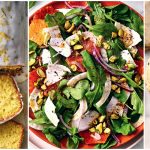Election Cake
Lightly yeasted, flavored with currants and spices, and baked until golden, these Election Cakes (you might also call them rolls) make the grade.

Election Cake
Photo Credit: Aimee SeaveyThis recipe is adapted from Lydia Maria Child’s recipe for Election Cake, which appears in the 1833 edition of The American Frugal Housewife, published in Boston. We have reduced Mrs. Child’s recipe by three-fourths and added a little spice, which was, and is, typical in election cake, though Mrs. Child omits it. In a cookbook of 1839, Lettice Bryan makes up her election cake in the form of “small flattish loaves” placed “close together” so that when risen and baked, they join together into one cake, like monkey bread. The idea is clever and attractive, and I suggest it here.
To our modern sensibilities, this light yeast cake us suitable for breakfast, for brunch, or with coffee or tea. Or try it sweet wine or hard cider, and imagine that you are back in the 17th century, celebrating after casting your vote.
Learn more about the History of Election Cake.
Yield:
24 servingsIngredients
1/4 cup lukewarm water
2 packages dry yeast
3/4 cup whole milk, heated to lukewarm
3 cups all-purpose flour, plus more for kneading and forming
6 tablespoons unsalted butter, melted and cooled
1 large egg, at room temperature
1/2 cup sugar
1 teaspoon ground or freshly grated nutmeg
1 teaspoon ground cinnamon
1 teaspoon salt
1 cup currants
Instructions
Pour the water into a 4- or 5-quart mixing bowl. Sprinkle the yeast over the top, and set aside until the yeast dissolves, about 3 minutes. Stir in the warm milk, then beat in 1-1/2 cups of the flour, making a stiff batter. Cover the bowl with plastic wrap and set aside in a warm place for 30 minutes (no longer).
Beat in the butter, egg, sugar, spices, and salt. Then work in the remaining 1-1/2 cups flour, making a soft, rough dough. Cover the bowl with plastic wrap and set aside for 15 to 30 minutes.
Knead the dough until smooth, for 5 to 10 minutes. It will be very soft and sticky. Gradually add more flour as necessary, a few tablespoons at a time, to form a smooth dough.
Knead in the currants. Roll the dough into an 8-inch log. Cut the log into 4 equal pieces, then divide each piece into 6 little rolls. To create surface tension so the rolls will puff up round, roll each into a little ball. One at a time, pinch 1 side of the ball with your fingers as though stretching loose skin, then tuck the stretched dough into a pucker at the bottom of the ball. Do this several times until the surface looks taut. Dredge the rolls in flour and arrange pucker-side down in a greased 9x13x2-inch baking pan, 4 rows across, 6 rows down. Loosely drape with plastic wrap and let rise in a warm place until generously doubled, 1-1/2 to 2 hours. The rolls should all be touching.
Set a rack in the lower-middle level of the oven. Heat the oven to 375 degrees F. Bake the cake until all the rolls are puffed and richly browned, and those in the center register at least 190 degrees F on an instant-read thermometer, about 20 minutes. Let the cake rest in the pan for 3 minutes, then gently shake the pan back and forth until the cake loosens. Invert the cake onto a cookie sheet, then reinvert it onto a rack. Serve warm or at room temperature, preferably on the day of baking.







